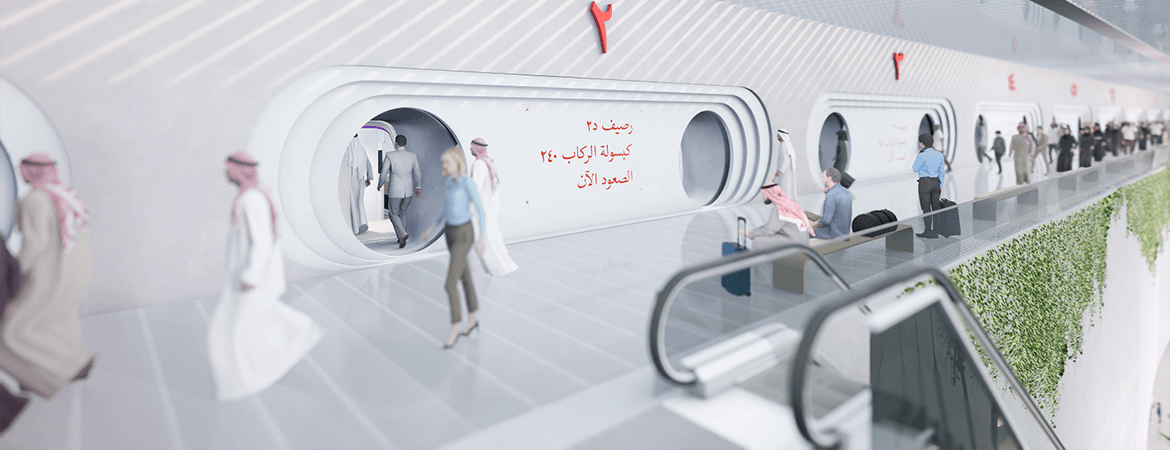Just months after its first passenger testing, Virgin Hyperloop has unveiled its vision for the future. The newly-released concept video takes the viewer step-by-step through a hyperloop journey, from arriving at the portal to boarding the pod.
DP World, the Dubai-based leading global provider of smart logistics solutions, is a major investor in Virgin Hyperloop.
Sultan Ahmed Bin Sulayem, Group Chairman and CEO of DP World and Chairman of Virgin Hyperloop, said: “Showing the passenger experience of Virgin Hyperloop is a glimpse of the future, following the success three months ago when people rode in a hyperloop pod for the first time. We have demonstrated the maturity of our technology. We are getting closer to commercialisation of what will be the first new mass-scale transportation mode in a century.”
“Designing a new mode of transportation from scratch is both an opportunity and a responsibility,” said Sara Luchian, Virgin Hyperloop’s Director of Passenger Experience and one of the first people to ride the hyperloop in November. “Hyperloop technology – and what it enables – is paradigm-shifting. It follows that the passenger experience should be nothing short of extraordinary.”
Groundbreaking design shows end-to-end passenger experience for the 21st century
Virgin Hyperloop worked with world-class partners across disparate industries – including Bjarke Ingels Group (BIG) for the portal designs, Teague for the pod designs, SeeThree for the video and animation, and Man Made Music for the score and sonic identity – to design a comprehensive, multi-sensory passenger experience that surpasses that of any other form of mass transit.
“Virgin Hyperloop can accelerate the future of mobility on land. The new mode of travel at supersonic speed rethinks transportation and the perception of space, landscape, time, and distance,” said Bjarke Ingels, Founder & Creative Director, BIG-Bjarke Ingels Group.”In this day and age, Virgin Hyperloop taking off from our portals provides holistic, intelligent transportation for a globalised community to travel across vast distances in a safer, cleaner, easier and faster way than airlines.”
Far from a dystopian future where dark colours, stark lighting, and screens abound, Virgin Hyperloop’s counter-narrative is a more optimistic view of the future: a greener, smoother, safer, and more pleasant mass transit experience.
“The passenger experience should be nothing short of extraordinary”
“We leveraged decades of experience designing how people and things move across various modalities – taking some of the best aspects from aviation, rail, automotive, and even hospitality to create a new and better passenger experience that is distinct to Virgin Hyperloop,” said John Barratt, CEO & President, Teague. “Recessed seat wells provide a greater sense of space, while the raised aisle is a touch of the unexpected and unique. Bands of greenery and wood textures subvert the aesthetic of typical mass transit materials with something optimistic and fresh. All lighting in the pod – including the unassuming information displays – is dynamic and adjust based on traveller activity and journey milestones.”
Beyond the typical touchpoints in transportation, Virgin Hyperloop also researched and incorporated findings from more non-traditional interactions, such as sound.
“Through proprietary research and a design thinking approach to creating sound and sonic solutions for Virgin Hyperloop, Man Made Music was able to address a myriad of potential challenges for this new mode of transportation, from how to evoke a sense of privacy and space to an enhanced sense of safety and calm,” said Joel Beckerman, Founder and Lead Composer at Man Made Music. “We respond to sound quicker than any other sense, so sound actually drives the multi-sensory experiences. The sonic cues of the Virgin Hyperloop identity system serve as a guide for passengers throughout their experience while instilling confidence, safety, and clarity – you ‘feel’ it rather than ‘hear’ it. Just like a great movie score, it tells you the story. We know when we’ve got it right when you don’t notice the sound at all: the interface is humanised in ways that are both fresh and familiar.”
The hyperloop system would be able to transport thousands of passengers per hour
A key pillar of Virgin Hyperloop’s passenger experience is accessibility, ensuring that this new form of transportation will expand opportunities for the masses. While ticket prices will vary depending on the exact route, a recent study in Ohio found that hyperloop fares would be more akin to the cost of driving, rather than flying.
“It’s simple. If it’s not affordable, people won’t use it,” said Jay Walder, CEO of Virgin Hyperloop. “Daily high-speed transport is currently not feasible for most people, but we want to change that notion. Imagine being able to commute between cities that are currently hours apart in minutes – and the endless possibilities that open up.”
On-demand and direct to destination, the hyperloop system would be able to transport thousands of passengers per hour, even though each vehicle carries only about 28 passengers. This high throughput is achieved by convoying, where vehicles can travel behind one another in the tube within milliseconds, controlled by Virgin Hyperloop’s machine intelligence software.
Following their successful passenger testing, Virgin Hyperloop is currently paving the way for the regulation and certification of hyperloop systems around the world. The company aims to achieve safety certification by 2025, with commercial operations – such as those depicted in this video – beginning in 2030.

